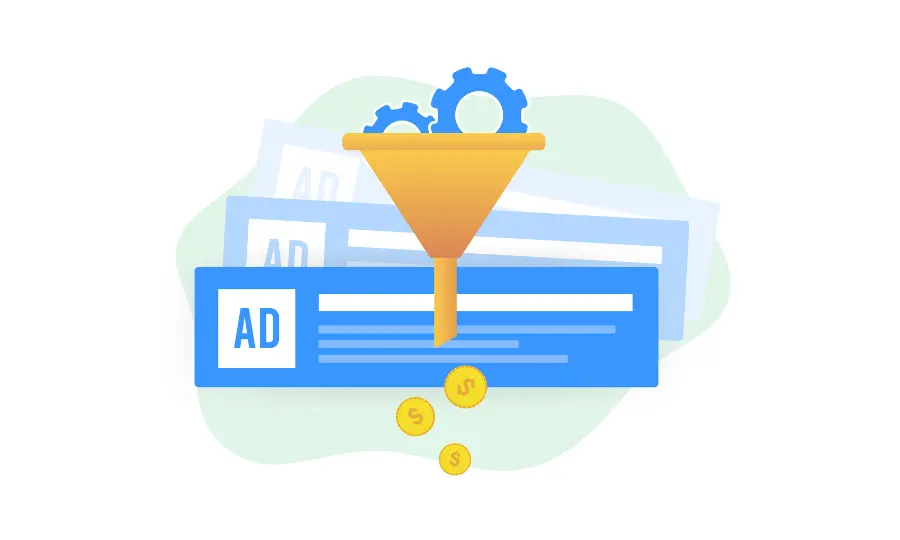Google Search Partners: The Complete Guide
This article will elucidate how Google Search Partners operate and the advantages they bring to your advertising strategy. These partners constitute websites on which Google ads may be displayed, thereby expanding the scope of your campaigns beyond just the Google search engine, with a potential boost in ad exposure and conversion rates.
Key Takeaways
- The Google Search Partners program significantly broadens ad reach beyond Google’s search engine, increasing visibility and engaging a wider audience on platforms like YouTube and other partner websites.
- Incorporating Google Search Partners into ad strategies can lead to increased conversions and reduced cost per lead, thanks to the expanded reach and lower cost per click (CPC) offered by these partner sites.
- Optimizing campaigns for Google Search Partners involves creating separate campaigns, utilizing targeted keywords, and regularly monitoring and adjusting bids to improve ad performance and achieve higher returns on investment.
Understanding Google Search Partners
Launched in 2003, the Google Search Partners program enables various partner websites to present search ads. The initiative allows advertisers to expand their advertising reach and pinpoint specific audiences across numerous sites. Aimed at amplifying the presence of Google search ads beyond just its own search engine, this program incorporates a mix of additional Google properties and various non-Google entities like YouTube into its network. By activating options within the Google Search Partners setting, advertisers can significantly widen their target audience base, enhancing visibility for their products or services and engagement levels from prospective customers.
Within the scope of the Google Search Partners Network, advertisements have potential placement on several types of pages – direct search results pages, directory listings, or other relevant pages connected to what users are looking for. This versatility means that your advertisements could resonate more effectively with diverse groups due to varied contextual environments where they may appear, thus increasing chances for interaction with consumers and boosting conversion rates.
Types of Google Search Partner Sites

Google Search Partners partner sites include various platforms, from other search engines and directory pages to content-oriented websites. These sites provide diverse avenues for placing advertisements, serving a wide spectrum of user activities and intentions related to searches. By strategically positioning your ads throughout these partner sites, you can significantly expand the reach to potential audiences and enhance the overall effectiveness of your advertising campaigns.
Exploring each type in greater detail reveals their individual contribution to this network.
Search Engines
The network of Google Search Partners encompasses a variety of minor search engines that are instrumental in extending the reach of your advertisements. Noteworthy among these partners are Dogpile, Ask.com, and Excite.com. By presenting ads from the Google Search Network within their own platforms, these smaller entities enable your advertisements to be displayed in search results beyond just those on Google’s primary platform.
By integrating with this array of alternative search providers in the Search Partners Network, you can engage audiences who favor these different engines over Google’s main service, effectively enhancing the exposure and visibility of your ads.
Directory Pages
Participating in the Google Search Partners program allows for ad placements on directory pages, including prominent ones like Amazon. This provides an opportunity to substantially extend your reach and connect with a broader audience since these directory pages typically draw users who are more likely to make purchases, making them prime locations for search ads.
Leveraging this strategic placement of search ads can greatly increase visibility and potentially boost conversion rates due to the high intent of users frequenting such directory pages.
Content Sites
The Google Search Partners network encompasses a variety of content sites, notable ones being YouTube and Google Shopping. The array of different Google sites included in the search partners network where ads can be featured consists of:
- Google Maps
- Google Images
- Google Groups
- Google Shopping
These diverse platforms offer numerous possibilities for ad placements within their rich content environments, thereby improving campaign performance by engaging users across various contexts.
Benefits of Using Google Search Partners
Utilizing Google Search Partners comes with several significant advantages. One notable benefit is the possibility of seeing a dramatic rise in conversions, with some advertisers reporting increases as high as 128%. Such an increase is due to the wider exposure and varied audience that partners within the Google Search network offer.
By tapping into this resource, there’s also the potential for lowered cost per lead. Campaigns can experience reductions by as much as 20%, presenting a financially savvy option for boosting return on investment. Traffic sourced through these partners often incurs lower costs per click (CPC), allowing companies to allocate their advertising budgets more effectively and get greater results from each dollar spent.
To financial benefits, collaborating with Google Search Partners facilitates:
- Shielding your brand-centric search results by preventing competitors’ ability to bid on your branded terms
- Maintaining strong visibility in search outcomes helps preserve brand authority and recognition
- Surging website visitors numbers—with certain brands witnessing extraordinary spikes such as 14,000% growth in site traffic
These collective gains explain why including Google Quick Look Carousel Solutions in your marketing initiatives can be extremely beneficial.
How to Enable or Disable Google Search Partners in Campaigns
Activating or deactivating Google Search Partners within your campaigns should be done with a clear understanding of what each choice entails. By default, Google Search Partners is included in the setup for any new campaign in the search network. This is intended to broaden your ads’ exposure and interaction opportunities.
To incorporate Google Search Partners into your campaign, you need to:
- Access your Google Ads account.
- Proceed to the settings for your campaign.
- Click on the Networks section.
- Check the box for Include Google search partners
- Click save.
Optimizing Your Campaigns for Google Search Partners

To maximize efficiency and effectiveness within the Google Search Partners network, adopting a methodical strategy for your campaigns is imperative. Critical optimization methods include:
- Establishing separate campaigns dedicated to search partners
- Employing precise keyword targeting practices
- Vigilantly observing bid levels and adapting them as needed
Adhering to these methodologies can lead you to enhanced outcomes on the Search Partners Network.
When applied together, these tactics improve the performance of your advertisements across the search partners in the Google Search ecosystem, guaranteeing optimal utilization of your advertising budget.
Separate Campaigns for Search Partners
Segmenting your ad campaigns to create distinct ones for Google Search Partners affords you enhanced control over budget distribution and bid adjustments. This tactic enables the allocation of dedicated budgets for traffic from partner sites and the ability to make bid modifications based on how these sites perform. Such detailed oversight helps meet crucial metrics and bolsters the optimization of your advertising efforts.
Keyword Targeting for Search Partners
Enhancing your ad performance on Google Search Partners is pivotal, and leveraging keyword targeting based on data from Search Partners can lead to marked improvements in campaign outcomes. Adopting the Single Keyword Ad Group (SKAG) strategy is essential for ensuring a high degree of relevance and clear segmentation with respect to keywords.
Initiating your campaigns by focusing on exact or phrase-match keywords and carefully reviewing performance metrics prior to making additional tweaks guarantees that your ads are precisely targeted and efficient.
Monitoring and Adjusting Bids
It is crucial to manage and refine bids using data on ad performance for effective results through search partners of Google. The process includes:
- Consistently evaluating the outcomes from partner sites and applications to pinpoint the most successful ones.
- Tailoring your bids, promotional messaging, and targeting strategies informed by collected data.
- Diligent monitoring and assessment of these changes are needed to ensure ongoing improvements.
Implementing this approach will likely boost your ad effectiveness across search partners.
Google introduced Smart Bidding for their search partner websites in 2018. This tool targets conversion at a cost-per-click comparable to google.com while simultaneously optimizing how advertising funds are allocated.
Common Misconceptions About Google Search Partners
Numerous misunderstandings continue to circulate about Google Search Partners despite their advantages. Advertisers must debunk these myths to fully capitalize on the capabilities of this network. Among these misconceptions are:
- The assumption that all Search Partners consist only of minor websites
- The notion that only conventional ads find success with Search Partners
- The idea that subpar performance is irreversible
We should examine these false beliefs closely and correct the misperceptions accordingly.
Misconception 1: All Search Partners Are Small Sites
The widespread belief that Google Search Partners consist solely of minor websites is mistaken. The network encompasses a mix of sizes, incorporating substantial sites like Amazon and Target. Including these larger sites means they draw in considerable visitors, resulting in numerous chances for your advertisements to engage with a wide-ranging and sizable audience.
Recognizing that prominent websites are part of the Google Search Partners highlights how varied and expansive this network truly is.
Misconception 2: Search Partners Only Work for Traditional Ads
There’s a widespread misconception that the capabilities of Google Search Partners are limited to traditional search campaigns. This isn’t the case. They can also effectively support shopping ads and advertisements on the display network, extending the reach of your marketing initiatives.
Understanding that Search Partners can accommodate multiple forms of ads allows marketers to craft more comprehensive strategies for their campaigns, significantly enhancing both their scope and impact.
Misconception 3: Poor Performance Cannot Be Improved
A common misunderstanding is the belief that one cannot enhance subpar results on Google Search Partners. Multiple optimization tactics are available to boost performance. Exploring different ad formats and trying out new features and product offerings can reveal the most effective strategies. Refineing issues associated with broad match keywords can significantly uplift outcomes.
Persistently optimizing and adjusting your methods is key to advancing the effectiveness of campaigns that initially show poor performance on Google Search Partners.
Identifying Traffic from Google Search Partners
It’s crucial to distinguish the traffic from Google Search Partners when reviewing and refining your advertising strategies. You can achieve this by breaking down your search query reports by selecting the ‘Network (With Search Partners)’ option. By doing so, you clearly see how well your ads resonate within Google’s extended network of partner websites.
Evaluating metrics such as click counts, click-through rates (CTR), and average cost-per-click (CPC) across campaigns that include or exclude search partners is instrumental in determining ad performance. Leveraging high-performing keywords discovered through these filtered search query reports allows for tailored campaigns directed toward Search Partner networks to boost campaign success.
Odd queries in these segmented reports may suggest they derive from clicks on hyperlinks leading to pages where users encountered ads via Search Partners—this gives additional context about user interactions with those advertisements.
Impact of Google Search Partners on Quality Scores
Advertisers frequently worry about the influence of click-through rates (CTR) from ads on partner sites within the Google Search Partner network on their Quality Scores in Google Search. It’s essential to understand that an advertisement’s CTR performance on these partner websites does not affect its Quality Score when it comes to Google itself. This separation ensures that your campaign optimization efforts can be focused without concern for how interactions with your ads on Google search partner platforms might alter your scores in actual Google searches.
Pros and Cons of Using Google Search Partners
Utilizing the Google Search Partner network comes with both benefits and drawbacks. On the upside, incorporating search partners into your advertising strategy can potentially lead to an upswing in conversions, which may vary depending on the specific industry and audience targeted by advertisers. For some campaigns, there have been reported increases in conversion rates due to enhanced reach and visibility provided by Google’s Search Partners. To this potential boost in conversions, activating Search Partners might contribute to lowering average costs-per-click (CPC) since these partner sites frequently boast lower CPCs than those found on Google Search itself. Consequently, this decrease in CPC could sustain a comparable cost per conversion rate, which may be an economical approach for various advertisers.
The augmentation of traffic volume is another merit of participating within the search partner network. Such growth can be particularly advantageous for brand-focused campaigns seeking widespread recognition and a greater portion of overall search query traffic capture. Advertisers must acknowledge that sometimes, the quality of partner sites’ generated clicks might not match what is obtained through traditional channels on the standard Google Search Network—potentially leading to diminished conversion rates or ineffective use of advertising budgets if performance outcomes are unsatisfactory.
Lastly, click-through-rates (CTR) resulting from ads displayed via search partners don’t directly impact keyword Quality Scores within individualized evaluations – their inclusion has ramifications for aggregate reports concerning campaign health measures because they introduce additional low-CTR impressions that could distort genuine results about effectiveness strategies at play. Therefore, while delineating positive aspects, negative considerations surrounding engagement should always maintain aligned reviews, ensuring added value consistently outweighs disadvantages associated with endorsing involvement in extended networks like those offered under the umbrella of “Google” branding efforts across digital landscapes and commercial interests.
Steps to Improve Performance on Google Search Partners

To enhance outcomes within the Google Search Partner network, a series of tactical maneuvers is essential. These include categorizing by device type, scrutinizing match types for relevance and efficiency, and preventing underperforming placements from receiving ads. Such measures ensure that advertisements are directed accurately while also improving budget optimization and bolstering the performance across search partners in the Google Search ecosystem.
Segment by Device
Optimizing ad performance by segmenting campaigns based on the device within the Google Search Partners network is essential. Careful examination of whether mobile or desktop devices garner superior results on search partner sites can lead to strategic enhancements tailored specifically for those devices that demonstrate optimal outcomes, thus ensuring your ads are finely tuned for efficacy across partner sites in the Google Search network.
Review Match Types
Maintaining the relevance of your ads on Google search partner sites necessitates a regular assessment and optimization of keyword match types. You can pinpoint any underperforming match types by examining performance data for keywords specifically within those search partner sites. For example, broad match keywords might not yield optimal results when used with partner sites and may require modification.
Experimentation with various offers and features is crucial to uncover potential opportunities that can enhance the efficiency of your overall campaign. Continuously testing these elements allows for iterative improvements in strategy effectiveness.
Block Poor Performing Placements
It’s imperative to exclude placements yielding subpar results so that your advertisements don’t appear on pages of inferior quality. Optimizing ad effectiveness and expenditure can be achieved by pinpointing and removing search partner sites known for their consistently lackluster performance.
Concentrating on securing high-quality spots will boost the efficacy of your marketing efforts, leading to improved campaign outcomes.
Summary
The Google Search Partners network is a critical asset for expanding the visibility of your ad campaigns beyond just the Google search engine. By tapping into this extensive collective of directory pages, various search engines, and content sites that are partners with Google, advertisers can connect with a wider audience to potentially enhance conversions.
Nevertheless, it is crucial to monitor your campaigns while using these partnerships to circumvent issues like low-quality traffic or inefficient use of advertising budgets. Customizing campaign settings by enabling or disabling access to search partners when necessary, separating campaign strategies according to viewer device types, refining keyword match types carefully, and filtering out underperforming placements all contribute to fine-tuning advertisement efficiency within this potent network. Employing the practices detailed in this guide will facilitate mastery over utilizing Search Partners effectively to improve business outcomes through more targeted reach efforts.
Frequently Asked Questions
What is the Google Search Partners network?
The network of Google Search Partners comprises various partner websites, which serve as platforms for displaying Google search ads. This extends the advertising presence not only within Google’s own search engine but also across additional sites owned by Google and websites that are not affiliated with Google.
How do I enable or disable Google Search Partners in my campaigns?
In your Google Ads dashboard, navigate to the campaign settings to activate or deactivate Google Search Partners by ticking or unticking the ‘Include Google Search Partners’ choice within the Networks section.
Do click-through rates on Google Search Partner sites affect my Quality Scores on Google?
No, the rate at which users click on ads within Google’s partner websites does not impact the Quality Scores assigned by Google.
What are the benefits of using Google Search Partners?
Incorporating Google Search Partners can expand the reach of an audience, enhance overall performance, and protect brand-related search results. It may also contribute to heightened conversions and diminish the cost per acquisition.
Leveraging this feature is advantageous for expanding your audience coverage and boosting your campaign’s effectiveness.
How can I optimize my campaigns for Google Search Partners?
For enhanced outcomes with Google Search Partners, establish distinct campaigns dedicated to them, employ precise keyword targeting strategies, and continually assess and fine-tune your bidding tactics according to performance analytics.

